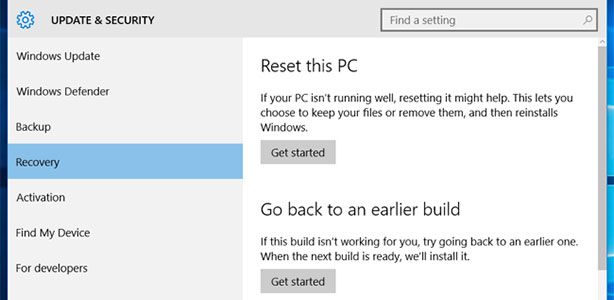
How to Restore the Computer to an Earlier Date
One of the most significant benefits of restoring a computer is that it can help fix problems caused by software bugs or glitches. Restoring your PC to an earlier date can often fix errors because when you restore it, you’re essentially undoing all the changes made since the date you’ve restored it.
Recommended: To easily install drivers automatically, use the tool below.
This can be especially helpful if you’ve installed new software or updates causing problems on your system. Restoring a computer can also be a great way to undo accidental changes or modifications.
Maybe you changed your desktop background without realizing that you didn’t want to, or perhaps you installed a new program that’s not working correctly. In cases like this, restoring your computer to an earlier date can often fix the problem without the hassle of uninstalling and reinstalling the software.
The article below will provide you with high-percentage methods to restore your operating system to a previous date and the pros and cons of doing so.
What is a System Restore?
A system restore is a feature of the Windows operating system that allows you to revert your computer’s state to a previous point. Windows 7 and Windows Vista choose the most recent system restore date and time when you do a system restore. But sometimes, you may want a less recent restore point in case an update was recently botched
Restore PC to an Earlier Date in Bootable Device
In a bootable device, performing a system restore via already existing system restore points in the windows operating system helps track the device back to the previous working condition. This can include CDs and USB drives. Here are the steps to restore windows via a recent restore point.
Step 1: In the search bar of the windows main menu, type system restore and launch it.

Step 2: In the system restore window, select Create a restore point option.
Step 3: In the next window, select the option of System Restore.

Step 4: Click Next to complete the wizard.

Step 5: If you already have a restore point, select the appropriate restore point and click next to continue. Follow the wizard to complete the action.

Restore Computer To Earlier Date In Safe Mode
Safe mode is a diagnostic mode in the operating system for the operating system that helps fix the operating system’s errors (windows). Using safe mode to restore the device to an earlier date can help to resolve various system errors. Here are the steps to follow:
Step 1: Boot the device via the windows main menu, i.e., click Shift and restart in the power menu to launch the device in safe mode. In the next window, click on the option of troubleshoot.
Step 2: In troubleshooting, select the option of advanced options

Step 3: Select system restore from the list in the next window.

Step 4: Follow the wizard windows and click next to continue.

Step 5: From the list of available system restore points, click on the latest one you want to pursue. After selecting a particular restore point, click next to continue.

Step 6: Click Finish to complete the wizard. Your device is set to an earlier restore point as the process completes.

Restore Computer To Earlier Date From Start-Up
A system restore operation can take the device back to normal working conditions without any data loss. A startup repair option can be used in this context to run a system restore.
A startup repair is a Windows Vista and 7 system restore that can be used to fix specific problems that might prevent Windows from starting correctly. A startup repair is similar to the System Restore feature because it allows you to restore your computer to an earlier date.
Here is how you can use the function.
Step 1: Launch startup by booting your device in safe mode. It could be done by booting a device with installation media or windows booting options. Boot devise from media. And select the repair your computer option from the popup window.

Step 2: In the next window, select the option of Troubleshoot.
Step 3: Select the option of advanced options.

Step 4: Select the option of System restore in the next window. Follow the wizard and select the targeted restore point to perform the restore process. Once the process completes, the device will return to an earlier point.

Restore Computer To Earlier Date Using Command Prompt
The Windows command prompt can also be used to help with system restores. If you are having trouble converting your computer using the built-in tools, try using the command prompt.
Command line action is another way to restore the computer to an earlier date. Hence, the command prompt is a quick fix to perform system restore. Here is how you can act.
Step 1: Boot the device by clicking the shift+ restart button. In the startup menu, select the option of troubleshoot.
Step 2: In the next window, select advanced options.

Step 3: Under the section of advanced options, select command prompt.

Step 4: In the prompt window, type rstrui.exe and click enter to continue. Follow the on-screen wizard to complete the action of system restore.

Restore from Windows Recovery
System restoration can be performed from the windows recovery options. Here are the steps to follow:
Step 1: Launch the settings menu from windows key+ I.

Step 2: Select the update and security option in the settings menu.

Step 3: In the update and security window, click on windows security in the left pane.

Step 4: Select the recovery option from the left pane in the next step.
Step 5: In the recovery section, click on the get started button for the option of Go back to the previous version of Windows 10.

How Long Does a System Restoration take?
The time it takes to go through a restoration varies wildly due to the number of variables involved. This includes the general system performance of the computer, the number of changes that have been made to the system between the snapshot and the present time, and other factors.
For your restore operation to be complete, System Restore essentially needs to uninstall Visual Studio 2022, reinstall the Microsoft 365 apps, and revert the Windows 10 version from 20H2 back to 1909.
Depending on your system’s performance and how many changes have been made since the snapshot, this process can take anywhere from a few minutes to hours.
What Can Go Wrong When Using System Restore Points?
Several things can go wrong with a system restore. One is that incompatible software can interfere with creating a restore point. If the restore point doesn’t get created correctly, you won’t be able to revert to it later.
Another issue is that specific applications may not uninstall properly when you revert to a restore point. This can leave your computer in an unstable state and may even prevent you from booting into Windows at all.
You also need to ensure you have enough free space on your C: drive for new restore points to be created. If there isn’t enough space, the restore points will start to fill up, and eventually, they will be deleted automatically.
What to do if Your PC says No Restore Points
If you’re trying to restore your PC using restore points and there are no available restore points, there are still a few things to try and fix the issue.
First, try restarting your PC. Sometimes issues restore points can be fixed by simply restarting your computer.
If restarting your PC doesn’t work, you can create a new restore point. To do this, press Windows Key + S, type Restore Point and select Create a restore point. Select the system drive (usually C:), then click the Create button. Once the restore point has been created, try restoring your PC to locate the previous restore points.
If creating a new restore point doesn’t work, you can try using System Restore from Safe Mode. To do this, restart your PC and press F8 before Windows starts loading.
Select Safe Mode from the list of options, then sign in with your account password (or if you don’t have one, click Skip). Once you’re signed in, open the Start Menu and type System Restore. Select System Restore from the list of results.
System Restore will open, and you’ll see a list of available restore points. Select the most recent one and click Next. System Restore will begin restoring your PC and should fix any issues causing problems with the previous restore points.

- Your machine is currently running Windows 10
- Fortect is compatible with your operating system.
Recommended: To repair Windows Errors, use this software package; Fortect System Repair. This repair tool has been proven to identify and fix these errors and other Windows problems with very high efficiency.

- 100% safe as confirmed by Norton.
- Only your system and hardware are evaluated.
Frequently Asked Questions About Restoring the Computer to an Earlier Date
Will System Properties be Default if I Enable System Restore?
Enable system restore will create a restore point automatically if there are changes to the system and the user has System Restore enabled. System Restore points can revert changes when they defaulted or restore the system to an earlier state. System Restore is available on Windows 10, Windows 8.1, and Windows 7.
What is a System Restore Point on PC?
A system restore Point (SRP) is a snapshot of your PC’s system files, settings, and programs that allows you to restore your PC to a previous state. You can create an SRP on your PC by going to Settings > Update & Security > Recovery and clicking the “Create a restore point” link.
How do I Use a Different Restore Point?
1. Open the Control Panel.
2. Click on System and Security.
3. Click on System.
4. In the left-hand column, click on Advanced system settings.
5. Click on the System Protection tab in the System Properties window.
6. In the System Protection tab, click on the Create button.
7. In the Create Restore Point dialog box, type in a name for your restore point and then click on the Create button.
Where is the System Properties Window?
Click on the “Settings” button in the “User Profiles” section. Click on the “Settings” button in the User Profiles Properties window. Click on the “Windows Settings” tab in the Profile Settings window. Scroll down to the “System Properties” section and click on the “Change” button.
How do I Activate a Restore Point Manually?
1. Click on the Start Menu, and type “system restore” into the search bar.
2. Click on “Create a restore point” in the results.
3. In the “System Protection” tab, click on “Create.”
4. Type a name for your restore point and click “Create.”
What is a System Backup Image?
A system backup image is a complete copy of your computer’s hard drive, including your programs, settings, and files. This image can restore your computer to its previous state in case of a hard drive failure or another disaster.
Do I Need to Use System Protection When Restoring my PC?
Yes, you will need to use system protection when restoring your PC. System protection creates restore points that allow you to undo changes to your PC. These restore points are created automatically by Windows, but you can also create your own.
How do I Open System Restore on Windows 10?
1. Open the Start Menu.
2. Type “Restore” into the search bar and hit Enter.
3. Select “Create a restore point” from the results list.
4. Click the “System Restore” tab.
5. Click the “Next” button.
6. Select a restore point and click “Next.”
7. Click “Finish.”
How do I Protect System Files in a System Restore?
You can protect system files in a system restore by creating an exclusion list. To do this, open the System Properties dialog box and click the System Protection tab. In the list of drives, click the drive on which you want to create the exclusion list, and then click Configure.
Click Add on the Exclusions tab under Select files and folders to exclude from the restore. In the Add Items dialog box, navigate to and select the file or folder you want to exclude, and then click OK.
What is System Restore Dates?
System Restore Dates work by creating a restore point for your computer. This restore point is a snapshot of your computer’s current state that you can use to restore your computer if something goes wrong. System Restore will also create a restore point every time you install a new program or change your system settings.
Should I Use Recent Restore Points or Old Restore Points?
Recent restore points are generally recommended because they contain the latest files and drivers that were backed up. However, if you are experiencing system problems, you may want to try using an old restore point.
What if the My Computer Fails to Complete a System Restore?
A recovery disc helps if a computer fails to complete a system restore because it allows the user to start the laptop outside Windows. This way, the user can access the system files and attempt to fix whatever is causing the computer not to complete the system restore.
What Happens When I Turn on System Protection on my PC?
Turning on system protection on your PC will create and manage restore points for you. These restore points will allow you to revert your PC to a previous working state if it becomes corrupted. System protection can also help protect your PC from being infected by malware by creating a restore point before you install new software or make changes to your computer.
How do I Use a Restore Point?
A restore point is a file created every time something is saved or downloaded by Windows. This file contains the registry and system files used when the restore point was made. You must first copy the restore point to your hard disk to use a restore point.
What is a System Image?
A system image is a snapshot of the state of a computer at a particular point in time. It can be used to restore the laptop to that exact state if something goes wrong or to migrate the contents of one computer to another.
Why Would I Need System Recovery?
One reason is that your computer may be running slowly or crashing frequently. In this case, a system recovery may help improve your computer’s performance. Also, if your computer is infected with a virus or malware, a system recovery may help to remove the infection. Recovering your system can also help you regain access to data that you thought was lost.
How are Restore Points Made?
Windows creates restore points by copying your system’s configuration and saving it to the System Restore Points folder. When you make a restore point in your PC, Windows also holds any new or changed files and folders to the restore point.
Why Can’t I Use System Restore?
One possibility is that System Restore is turned off on your PC. If System Restore is turned off on your PC, you can turn it on by doing the following:
Open Control Panel and click System and Security. Click System. Under “System protection,” click Configure system protection. Select the drive you want to protect (usually C:), and then click Configure. Ensure the “Turn on system protection” box is checked, and click OK.
Will a System Restore Delete My Most Recent Windows Update?
A system will delete any updates or installs you have made to your PC since you restored it. When you restore your operating system, you are recovering a previous state in which your PC was.
Why Wasn’t My Restore Point Created Successfully?
You may need to disable your antivirus software if you cannot create a restore point. Restoring the Windows operating system creates points, and some antivirus programs may interfere with this process.
How do I Restore Settings?
1. In the Settings window, select Update & Security.
2. In the Update & Security window, select Recovery.
3. In the Recovery window, under Advanced startup, select Restart now.
4. Your computer will restart, and you will be taken to a screen where you can choose an option. Select Troubleshoot.
5. In the Troubleshoot window, select Advanced options.
6. In the Advanced options window, select Startup Settings.
7. In the Startup Settings window, select Restart.




